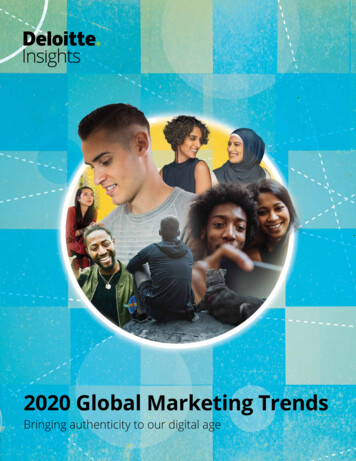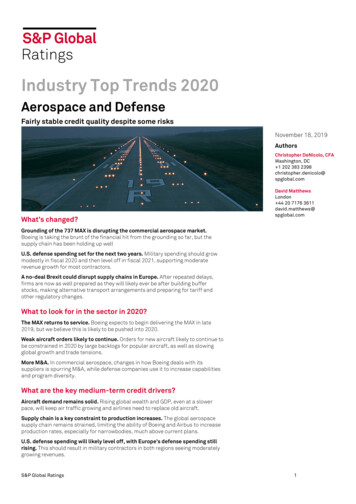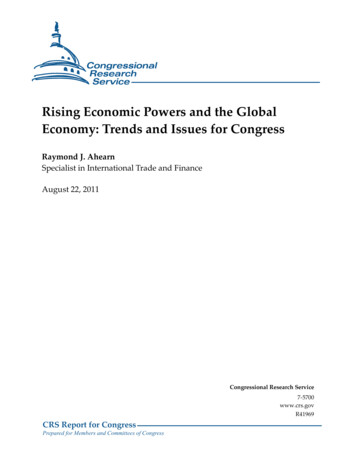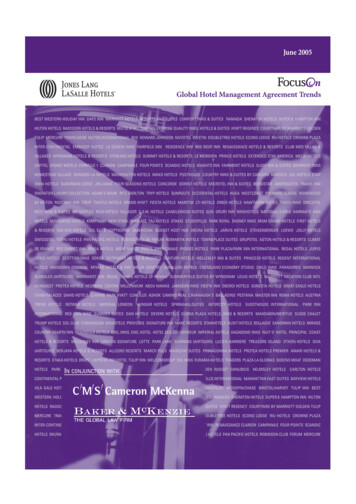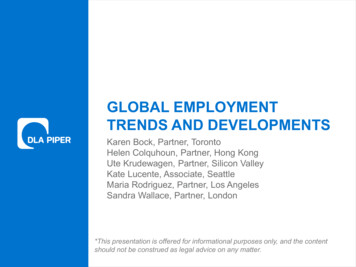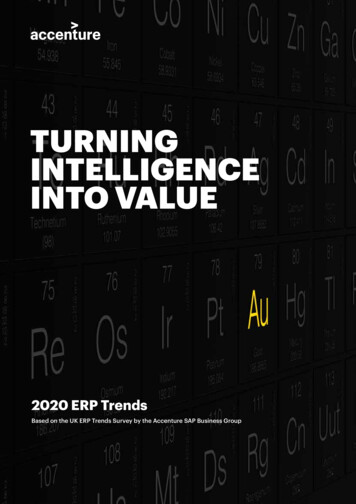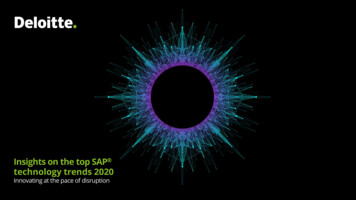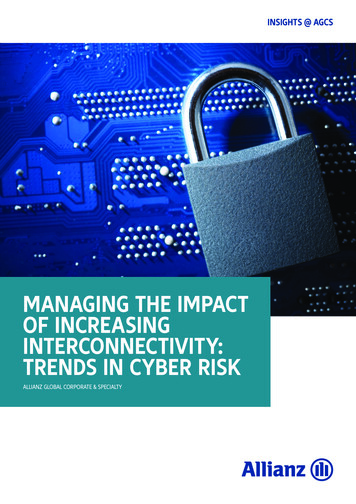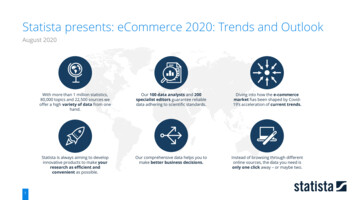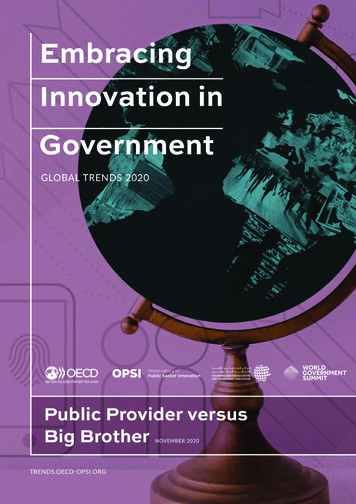
Transcription
GLOBAL TRENDS 2020This document and any map included herein are without prejudice to thestatus of or sovereignty over any territory, to the delimitation of internationalfrontiers and boundaries and to the name of any territory, city or area. This work is licensed under a Creative Commons Attribution– ShareAlike3.0 IGO (CC BY-SA 3.0 IGO), with the exception of sourced images, whichare copyrighted as credited.22
Table ofContents04INTRODUCTION08KEY THEME 01: Data harvesting and monitoringData HarvestingMonitoring and surveillanceCombining technological approachesLimitations and pitfalls to considerCASE STUDY: Collecting Mobile Data About Women to Build Safer Public Transportation (Chile)KEY THEME 02: Biometric technologies and facial recognitionTABLE OF CONTENTS24Leveraging biometrics for programmes and servicesDesigning policies for managing biometric technologies and dataCASE STUDY: Facial Verification for National Digital Iidentity (Singapore)CASE STUDY: Designing a Biometric Policy for Humanitarian Aid, International Committee of the Red Cross48RECOMMENDATIONS50CONCLUSION52REFERENCES3
GLOBAL TRENDS 2020OPSI serves as a global forum for public sector innovation,MBRCGI works to stimulate and enrich the culture of innovationhelping governments to understand, test and embed newwithin government through the development of an integratedways of doing things through the application of fresh insights,innovation framework. The goal is for innovation to become one ofknowledge, tools and connections.the key pillars of the UAE government with the aim of developingoecd-opsi.org@OPSIgovgovernment operations and enhancing competitiveness to makethe UAE one of the most innovative governments around the er@mbrinnovationinfo@mbrcgi.gov.aeIntroduction4
PUBLIC PROVIDER VERSUS BIG BROTHERThe OECD Observatory of Public Sector Innovation (OPSI) and the United Arab Emirates (UAE) Mohammed Bin Rashid Centrefor Government Innovation (MBRCGI) have spent the last year conducting research and analysis to understand how governments and their partners are innovating to cope with rapid change, increasing complexity and uncertainty, accelerating technological transformation and ever-increasing demands from the public. As part of the MENA-OECD Governance Programme,1we have conducted extensive research and held a global Call for Innovations crowdsourcing exercise to surface key innovation efforts2 and met with innovation teams from around the world to hear their stories (Figure 1). Many of the cases identifiedthrough this work are included on OPSI’s public Case Study Platform.3Figure 1: Crowdsourcing and research to surface trends and cases396 cases fromCall forInnovations683 innovations consideredfrom 91 countries287 cases fromextensiveresearchThrough this work, OPSI and the MBRCGI have found that governments are taking exciting and innovative actions to transform themselves. Throughout 2020, OPSI and the MBRCGI are issuing a series of five report on 2020 trends in public sectorinnovation,4 which will culminate in the launch of the final report at OPSI’s two-day virtual event Government After Shock: Anunconventional event for unconventional times on 17-18 November 2020.5 The trends surfaced for 2020 build upon and demonstrate the evolution of the remarkable efforts detailed in our previous Global Trends series of report.6https://oe.cd/gov-after-shockThe first report for 2020, published in July, detailed key themes for innovative responses to the COVID-19 crisis, whichcontinues to unfold and presents countless and cascading challenges. In September, the second report found that whilegovernments continue to grapple with COVID-19, they are taking action to bring about seamless government by innovating toeliminate points of friction with those they serve and actively shaping tomorrow’s possibilities with action today. In October,the third report in the series explored the issues of focusing on the overlooked, and how governments are using innovativeapproaches to provide new opportunities for disadvantaged and underserved groups.1 https://oe.cd/mena-gov.2 https://oecd-opsi.org/call-for-innovations-2020.3 https://oecd-opsi.org/innovations.4 Each report and an accompanying digital story are published at https://trends.oecd-opsi.org.5 See https://gov-after-shock.oecd-opsi.org. All innovators are invited to participate.6 The reports for 2017-2019 are available at https://oe.cd/innovationtrends.5
GLOBAL TRENDS 2020For the fourth report in this series, OPSI and the MBRCGI’s research explores the powerful new technologies and opportunities that governments have at their disposal to let them better understand the needs of citizens. The research showsthat governments must be cautious in exploring these possibilities and should leverage them in ways that do not underminepublic trust. Governments need to balance the tensions of using data harvesting and monitoring, and technologies that canidentify individuals, to serve the public interest, with the inevitable concerns and legitimate fears about “big brother” andrisks of infringing on freedoms and rights. Through the lens of navigating Public Provider versus Big Brother, innovation effortsfall into two key themes:01 : Data harvestingand monitoringGovernments have access to more detailed data thanever before as well as sophisticated analysis andmonitoring methods, techniques and devices to understand the lived experience of citizens and providerelevant services. However, such access involvesrisks and considerations which require serious reflection on the part of government.02 : Biometrictechnologies andfacial recognitionA range of facial and body recognition and other biometric tools offer opportunities to provideINTRODUCTIONeasy access to tailored services, as well as theunprecedented ability to identify and track individuals and gather unprecedented knowledgeabout their behaviours and movements.6
PUBLIC PROVIDER VERSUS BIG BROTHERThese themes are discussed in this report alongside real-world examples and case studies.Collecting Mobile Data AboutWomen to Build Safer PublicTransportationCHILEA “data collaborative” in Santiago analyses private telecoms data about where and whenpeople make mobile phone calls, along with a range of open data and socioeconomicinformation, to better understand the gendered dimensions of urban mobility.Facial Verification forNational Digital IdentitySINGAPORESingapore is developing a biometrics system as part of their National Digital Identityprogramme to allow citizens to make transactions for both public and private services,such as banks, through the use of facial verification rather than passwords orphysical ID cards.Designing a Biometric Policyfor Humanitarian AidINTERNATIONAL COMMITTEE OF THE RED CROSSAs biometric projects and services continue to grow, policies governing their useare lagging behind. Accordingly, the International Committee of the Red Crosshave designed their own policy, which offers a number of lessons and goodpractices for governments pursing their own.OPSI and the MBRCGI explore these and other efforts in what is a challenging and evolving field, with the aim of aiding others in their learning and testing of these contentious issues. Governments need to engage with these new opportunities butmust equally be aware of the limits of citizens’ tolerance and the dangers involved in accelerating too far, too fast without thenecessary safeguards.As a result of this work, OPSI and the MBRCGI have developed three key recommendations to help guide governments inexploring the use of technology to collect new types of data and insights:1. Actively engage with the issues raised by these technologies.2. Prioritise earning trust from the public in order to successfully implement servicesthat leverage these technologies.3. Work collaboratively across national borders in order to understand the limits, pitfallsand opportunities of these technologies.7
GLOBAL TRENDS 2020KEY THEME 01Data harvestingand monitoring8
INTRODUCTIONPUBLIC PROVIDER VERSUS BIG BROTHER9
GLOBAL TRENDS 202010
PUBLIC PROVIDER VERSUS BIG BROTHERData are fundamental to effective and efficient government and the digital transformation of the public sector. Data underpin the provision of programmes and services, allowing governments to verify identities and distribute benefits based oneligibility criteria; data enable the monitoring and maintaining of natural and environmental resources; data form the core ofpolicy research, ensuring sound and evidence-based decision making; and data are central to understanding, reporting onand improving operations and outcomes. For this and other reasons, the OECD (2020a, 2019a, 2019b, 2017) and governmentsaround the world have recognised data as a strategic asset, the value of which increases when easily accessed, shared, usedand re-used, as appropriate.As the COVID-19 pandemic has demonstrated, governments have a genuine need to know what is happening and who isdoing what and to whom in real time. Various technologies and techniques can provide a rich source of data for governments,particularly those that enable monitoring in different forms. The full capabilities and potential of some of these technologiesand techniques are still being discovered, and their strengths, drawbacks and other considerations are being explored by thepublic sector. Likewise, there are strong civil society concerns about overreach or the risk of breaching personal privacy andliberties. Can governments navigate this uncertain terrain and use new technologies effectively to discern and deliver what isneeded and expected of them, without stepping into “Big Brother”7 territory?Data harvestingA digital world produces an incredible amount of data, as interactions and behaviours are captured by mobile devices andother sensors, providing insights into every aspect of people’s lives. The continued growth of the Internet of Things8 will onlymagnify this trend, as even mundane activities start to provide potentially significant data about people and their behaviours.Data harvesting, thus, can provide governments with important insights into real-time events, trends and behaviours on theground. It can also help explain why things are happening in a particular manner. As the case study on “Collecting mobiledata about women to build safer public transportation”, presented later in this report, demonstrates, data harvesting canreveal the extent of problems that might otherwise have gone undetected or proven difficult to map – in this case, variationsK E Y T H E M E 0 1 : Data harvesting and monitoringin the use of public transport by men and women. Armed with such insights, governments can devise interventions to addressidentified issues and challenges.Data harvesting can also be a valuable tool during or after emergencies, as governments try to assess the extent of impactson a population. This is particular important in terms of delivering timely responses or assistance, especially in the case ofdisaster relief. Rapid information feedback loops are crucial to make good decision making in urgent situations. A recentstudy observed the use of a number of new big data sources in disaster relief, including satellite and aerial imagery, dronevideos, sensor web networks and the Internet of Things, spatial data, crowdsourcing, real-time social media, and mobile GPSand telecoms data (Yu, Yang and Li, 2018).This trend has become particularly apparent in recent years with regular wildfire disasters in North America (BBC News,2020), Australia (Givetash, 2020) and even the Arctic Circle (Witze, 2020). In California, US, the city of Los Angeles has beenusing big data analytics to assist their response in real time. The Fire Department partnered with the San Diego Supercomputer Center and their WIFIRE Lab to develop a programme capable of making predictions about where fires would spread,using information about local geography, weather conditions and potentially flammable materials, all gathered from government data sets and local sensors (Del Real, 2019). The WIFIRE Firemap is described by its creators as a “decision-support andinformation tool”, and is used as such, helping to make predictions instantly, by combining data sets and analytical techniques, and modelling them on a public platform (see Figure 2). Its popularity during wildfires in 2018 led to broader usage byother fire departments and national government support for the tool.97 https://en.wikipedia.org/wiki/Big Brother (Nineteen Eighty-Four).8 nternet-of-things.pdf.9 See also the uses of data harvesting in the first 2020 innovation trends report, Innovative Responses to the COVID-19 Crisis, at https://trends.oecd-opsi.org.11
GLOBAL TRENDS 2020Figure 2: WIFIRE’s Firemap platform showing a fire outbreak in Napa ValleySource: egos-firemap.K E Y T H E M E 0 1 : Data harvesting and monitoringTaking the predictive approach even further, Portland, Oregon, created a Fire and Rescue Blueprint for Success,10 based onthe emergent understanding that the main deaths by fires in cities do not occur as a result of large conflagrations engulfing skyscrapers and neighbourhoods, but are actually small events associated with social, health and economic status. Assuch, the city is using data on poverty, blight, drug addiction, mental health and homelessness as part of their ambitiousplan to reach zero deaths from fire.Such analytics can have a wide range of uses. A study from Deloitte describes a number of examples of governmentsaround the world using data harvesting and analytics to identify, understand and attempt to address more long-term, complex problems. For example, Luton Borough Council, located just outside of London, has been using data modelling to identify individuals in the borough at greater risk of homelessness. By combining income and other financial data, and focusingon risk factors, the council was able to identify low-income households – or, specifically, those with low financial resilience.By correlating these findings with other socio-demographic data, the council can effectively model the impacts of new policies, such as the Universal Credit scheme, and determine how they would affect certain households, thereby enabling themto track and target those households to provide preventative assistance (Alvarez Vilanova, 2018). Moving beyond passivelygained insights on current status, data harvesting can help governments simulate and model the potential effects of theirpolicies and other interventions. The use of data for anticipating and planning is discussed in the OECD report The Path toBecoming a Data-Driven Public Sector (OECD, 2019a).Data harvesting can also help people better understand their own lives and the environment in which they live. Harvestinga wide range of data and making them accessible and relevant can help better inform people about issues affecting theirquality of life, and perhaps lead them to make different decisions and choices (see Box 1).10 www.portlandoregon.gov/fire/77452.12
PUBLIC PROVIDER VERSUS BIG BROTHERBox 1: The HOPE projectThe HOPE project in Helsinki aims to produce a comprehensive hyper-local air quality monitoring networkincluding crowdsourced portable monitors that give citizens air quality information on exposure to air pollution inthe places where they live and travel in the city. The project focuses on three districts in Helsinki that experiencevarious air quality challenges. The first major milestone of the HOPE project is the planning and building of threestate-of-the-art local monitoring networks in these areas.In addition to building monitoring networks, the project has launched crowdsourced campaigns for mobile sensor devices to measure air quality. Up to 100 citizens at a time will carry the devices which will produce hyper-local, real-time air quality data, which can be processed as a part of regional air quality information, maps andforecasts. State-of-the-art technologies developed through the project, such as AI algorithms, machine learningand edge-computing, are used in calibrating the sensors and crunching the data.Source: https://oe.cd/hope-project, https://ilmanlaatu.eu.As governments not only gain access to richer and more sophisticated data through different means of data harvesting,there will be opportunities to better understand the service delivery context and the factors shaping the policy environment.Monitoring and surveillanceRelated to and often building upon data harvesting, advancements in technology are also providing governments with morepowerful abilities to survey real-time events through monitoring and surveillance. Surveillance, defined by Lyon (2007, p. 14)as ”any focused, routine or systematic attention to personal details, for the purpose of control, influence or management”,is becoming easier to conduct, and so perhaps, unsurprisingly, more common. As Lyon notes, surveillance is endemic tothe modern state and constitutes a key feature of bureaucratic administration for purposes such as tracking compliance.K E Y T H E M E 0 1 : Data harvesting and monitoringHowever, surveillance also has negative connotations, with the word itself prompting a visceral reaction among some. Thisis especially true where it is perceived as veering into areas of control and influence rather than the more mundane area ofmanagement.11 Nonetheless, monitoring and surveillance efforts are growing in government, warranting a discussion andfocus on the topic.A common manifestation of modern day surveillance is the use of cameras, particularly closed-circuit television (CCTV).Some cities have introduced cameras in large number to provide a sense of safety and to try to prevent and track crime.Given their proliferation, OPSI does not consider video monitoring and surveillance activities to be innovative. However, theimplications and possibilities of video surveillance take on a new dimension when such cameras are mounted on a drone.Real-time surveillance with drone scouts allows first responders to gain access much faster to information about potentialincidents and better assess the needed response, potentially saving time and delivering more effective outcomes (see Box 2).Louisville, Kentucky is also experimenting with drone-based incident response.12 OPSI and the MBRCGI observed a noticeable uptick in drone programmes in this year’s research and Call for Innovation. Some governments have issued specificguidance on drones and their relation to privacy principles – one example being the guidance developed by Queensland, Australia.13 The European Union has provided funding to Drone Rules, an awareness-raising campaign and online course on dronelaws and regulations across the European Union, including a code of conduct and privacy rules. Drone Rules also releasedspecific guidance on aligning drone usage with the General Data Protection Regulation (GDPR).1411 It is important to note the distinction, on the one hand, between smaller-scale monitoring and surveillance activities that seek to improve general public safety and theefficiency and effectiveness of government policies and services, and, on the other, government surveillance programmes that seek to protect national security. OPSI’scurrent portfolio of work and expertise does not include national security or the organisations and agencies that support this field, and data harvesting or surveillanceprogrammes that fall in this area do not fall within the scope of this report.12 https://oe.cd/air-incident-response.13 4 See https://dronerules.eu/assets/covers/DroneRu
public trust. Governments need to balance the tensions of using data harvesting and monitoring, and technologies that can identify individuals, to serve the public interest, with the inevitable concerns and legitimate fears about “big brother” and risks of infringing on freedoms and rights.
